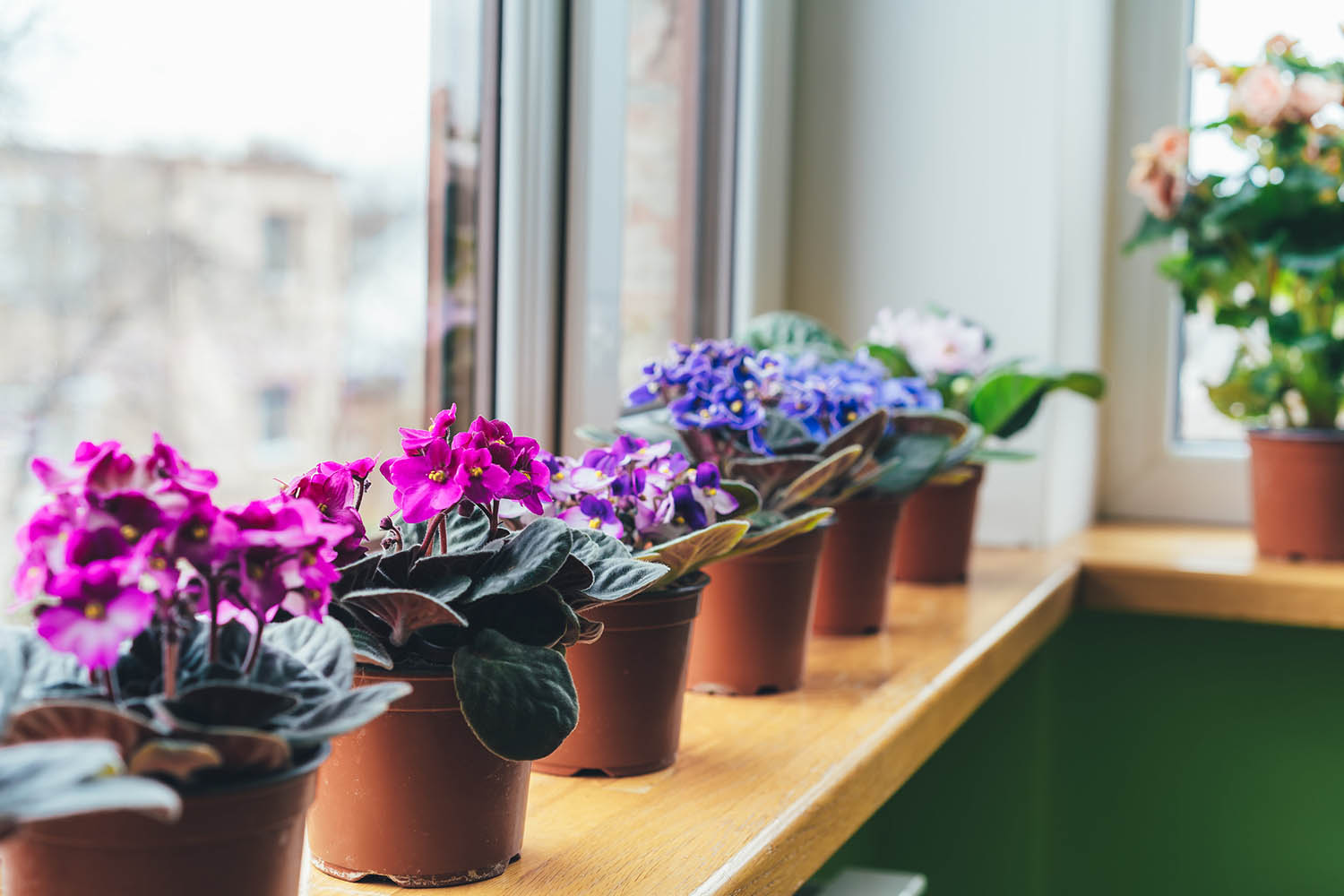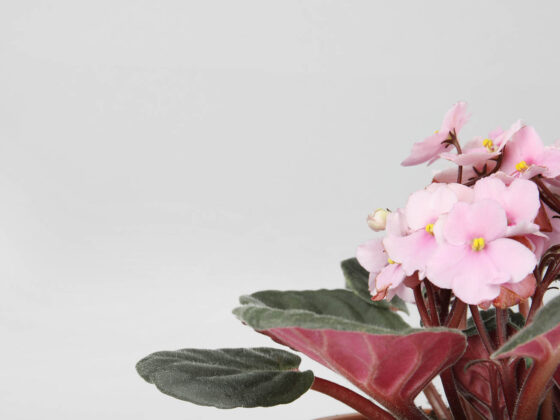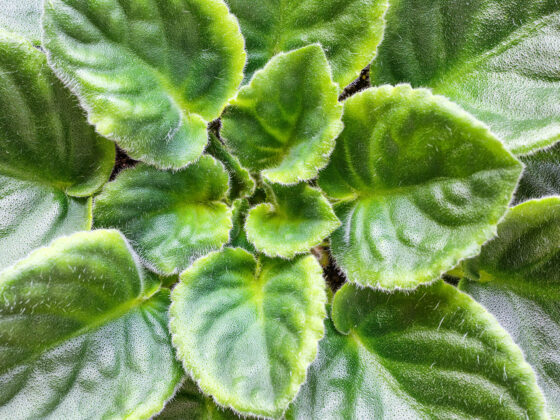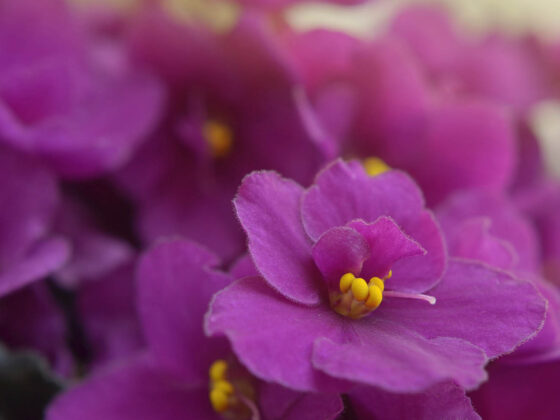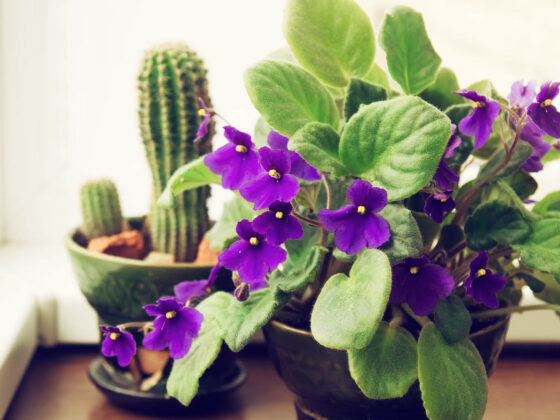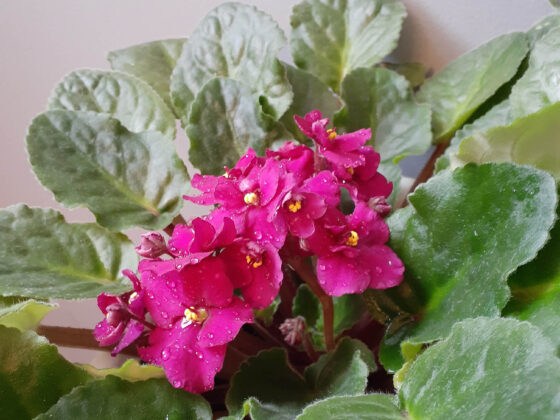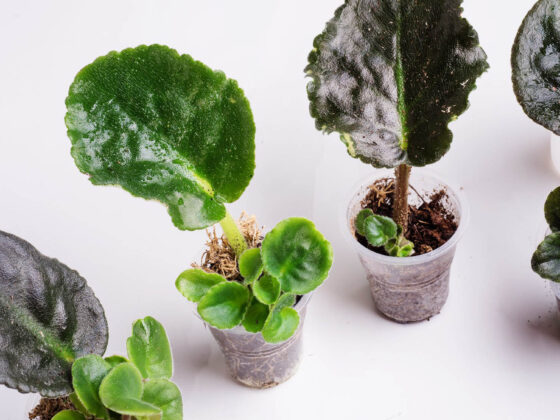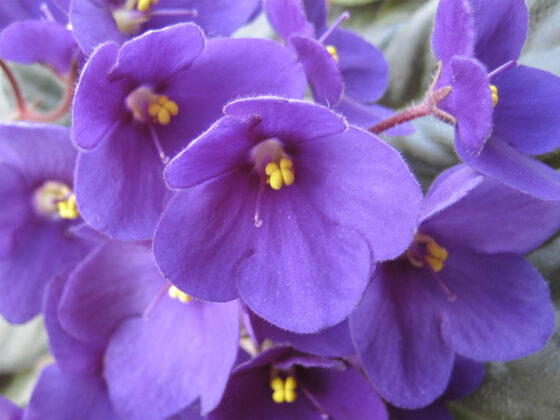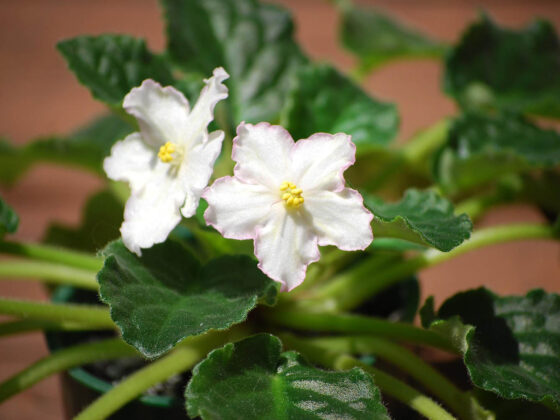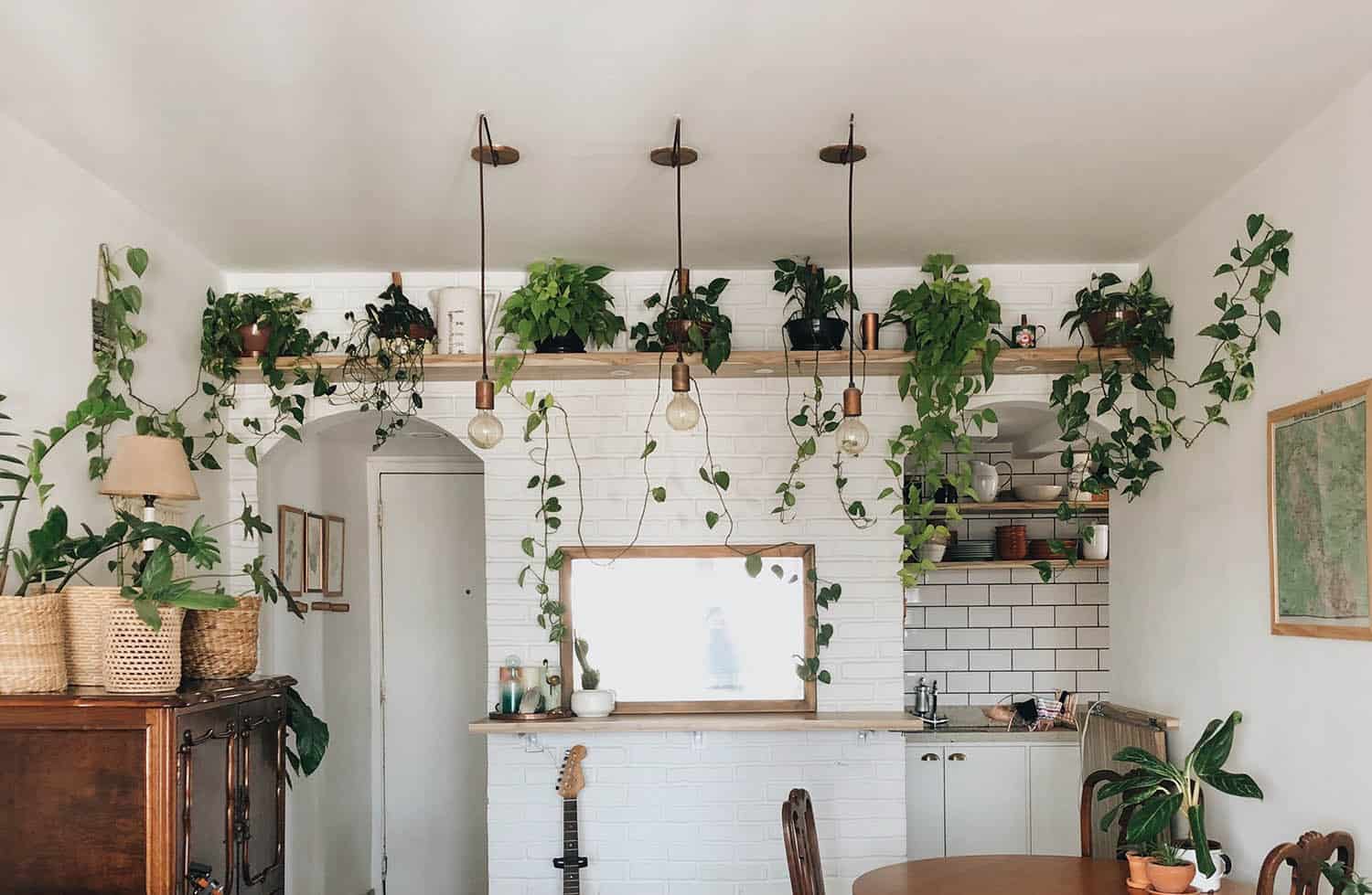Choosing a good pot and soil is how you lay the groundwork for your African Violet’s growth. Your Saintpaulia will be much easier to care for when you’re not fighting against a poor root environment. This post will explain what your African Violet needs from its potting mix and container.
African Violet soil should allow air and water to flow but hold enough moisture to keep the roots moist. Start with a mix of perlite, vermiculite, and spongy fibers like coir or peat moss. A little compost for nutrients helps too. The best pot for your African Violet will be fairly shallow with good drainage.
You should always be prepared to make adjustments to suit your plant, your location, and your care style. We’ll help you understand how your choice of soil and pot affects your African Violet’s other needs. Once you know that, you’ll be able to adapt on the fly without our help!
What Kind of Soil Do African Violets Like?
When they’re not inside our homes, offices, or greenhouses, African Violets live in the high-altitude rainforests of eastern Africa. They grow in the mossy cracks of rocks, nourished by rain, mist, and rotting bits of other plants.
That’s a pretty far cry from the kind of soil most of us have in our lawns and gardens. Your typical outdoor soil is much too thick for a Saintpaulia. You should always grow your African Violet in a soilless potting mix.
For the sake of convenience, we’ll use the terms “potting mix,” “potting soil”, and just plain “soil” interchangeably. But remember that you should never plant a Saintpaulia in actual garden soil.
What Makes a Good African Violet Soil
What should you look for when you’re picking a soil for your Saintpaulia? There are three main factors:
Number 1: Drainage
The biggest risk of using the wrong kind of potting mix is that it may hold too much moisture. When there’s a lot of water in the soil, it fills the tiny holes that normally hold oxygen. This weakens the roots, which need air to breathe, and encourages certain kinds of fungi and bacteria. This leads to a dehydrated plant with rotting roots.
Though we usually call this problem “overwatering”, it often has more to do with the soil than the watering can. It’s hard to avoid a swampy pot when the potting mix is so dense that water can’t escape.
We’re not going to get too deep into the physics of it all, but the basic rule is that soils with smaller particles hold more water. Coarser blends leave bigger gaps for air and allow excess liquid to trickle out faster. Your African Violet needs a soil with decent drainage to live its best life.
Number 2: Retention
African Violets won’t stay healthy if their roots are constantly drying out. Their soil should stay a little bit damp between waterings. This keeps them from getting dehydrated.
That might sound like it’s contradicting everything we just said about drainage. The key is to strike a balance. You don’t want your soil to hold so much liquid that it turns into sludge. And you don’t want all the water to drain away before your African Violet can drink it.
What you’re shooting for is soil that’s around as damp as a mop head you’ve just squeezed out. Obviously, it will be wetter than that right after you water, and drier after sitting for a few days. But keep it as close to that as you can.
Number 3: Support
Saintpaulias have thin, delicate roots. In the wild, they like to anchor onto craggy rocks for support. When there’s nothing to prop up their root systems, they won’t be able to grow to their full potential.
We’re not saying you need to put big rocks in the pot. However, it’s good if the soil includes a bit of grit for your African Violet to cling to.
What To Put in African Violet Potting Mix
We’re going to suggest a couple of specific blends for your African Violets a little further down. First, though, we want to explain what each ingredient contributes to the mix. This will make it easier to tweak the formula based on your care approach.
Peat Moss
This is a classic base ingredient for potting mixes, and most store-bought blends use a lot of it. It’s good for water retention, and it lowers the pH of the soil, which is good for acid-loving plants like African Violets. However, it has an annoying tendency to become water-repellent if it dries out all the way.
Coconut Coir
Another water-retentive ingredient that’s light and airy. It’s pH-neutral, and some people consider it more eco-friendly than peat moss. On the other hand, it’s generally more expensive.
Vermicompost
Loose, spongy crumbles of organic matter produced by earthworms. It’s good for the soil structure and provides a low, gentle dose of nutrients, reducing the need for fertilizer. It holds quite a bit of moisture, so don’t make it more than 15-20% of your total mix. Also known as worm castings or earthworm compost.
Dolomite Lime
Crushed-up limestone. Provides some calcium and magnesium, but the main purpose is to balance the pH a bit if it’s too acidic due to the peat content.
Vermiculite
This crumbly mineral substance can soak up a fair amount of water. But the coarse horticultural-grade kind also leaves space for aeration. It’s a borderline ingredient between the finer materials that provide water retention and the grittier ones that allow drainage.
Perlite
Perlite is basically a coarser version of vermiculite that’s very useful for boosting the drainage of soil mixes. It’s nice and chunky, giving your Saintpaulia’s roots something to grip.
Conifer Bark
Big chunks of bark are good for drainage and structure. They’re slightly acidic, too.
Pumice
This porous rock works a lot like perlite, though it’s heavier. It’s excellent for anchoring delicate roots.
How to Make Potting Mix for African Violets
A good rule of thumb for making African Violet soil is to emphasize drainage slightly more than water retention. A little less than half of the mix should be squishy organic materials like peat moss. The rest should be coarse and rigid elements, to create air pockets.
We’d suggest using 40% perlite, 30% coconut coir, 20% vermiculite, and 10% worm castings. The perlite and vermiculite leave a good amount of space for drainage while still taking up some water. The coconut coir and vermicompost help your Saintpaulia stay hydrated, and the compost also provides some nutritional support.
Pay attention to how quickly the pot dries out and how well your African Violet is thriving. You may end up wanting to fiddle with the ingredients or the ratio. For example:
- Increase the perlite content or replace the vermiculite with pumice if it’s not draining fast enough.
- Use peat moss instead of coir if the pH is too high – African Violets do best between 6.5 and 6.8.
- Add a bit of dolomite lime if the pH is too low.
- Up the fraction of coir or peat if the mix dries out too quickly.
- Boost the vermicompost to 20% if your plant isn’t getting enough nutrition.
Before mixing your ingredients, screen and/or rinse any perlite or pumice you’re using. This will remove dust and small chips that counteract the drainage benefits. Then you can just stir all the ingredients together thoroughly in a big bucket or box.
Note that you might want to use eye protection and a painter’s mask when handling perlite. It tends to give off dust clouds.
Should You Buy Potting Soil for African Violets?
Why make a custom soil blend when your local garden center offers ready-made potting soil? Unfortunately, even soilless mixes tailor-made for indoor plants may suffocate an African Violet. Commercial blends tend to be overly water-retentive. This makes things easier on beginners who may forget to water, but it’s not ideal for your Saintpaulia’s health.
If you’re determined to buy a premade mix, get one that’s made for African Violets. Even these are often slightly too dense. We’d suggest mixing it with some more perlite or pumice for drainage. Try using ⅔ potting soil and ⅓ perlite.
The Best Pots for African Violets
Your African Violet’s container affects its root health almost as much as the soil does. What kind of pot will make your plant happiest?
The first thing to consider is drainage. Use a pot with at least one good sized-hole to let excess water escape. The material of the pot doesn’t matter much, though unglazed terra cotta containers will drain faster. Their porous sides offer much more surface area for water to evaporate.
African Violets have shallow root systems that tend to spread out rather than dig down. So it’s best to keep them in a vessel that’s wider than it is tall. The style of pot that people use for Azaleas – with a height that’s ¾ of the diameter – is perfect. A pot that’s too deep will leave a lot of unused soil that takes longer to dry out. This increases the odds of root rot.
Despite some claims you’ll find on the internet, African Violets don’t “like to be root bound”. (No plant does – “root bound” means that the roots are packed too tightly to absorb enough water.) However, a slightly snug pot encourages blooming and makes overwatering less likely. Pick a pot that’s about ⅓ as wide as the diameter of your Saintpaulia’s foliage.
Bottom Watering and Self-Watering African Violet Pots
Many indoor gardeners prefer to water their African Violets from the bottom. This lets the soil soak up moisture with no risk of getting the leaves wet and causing spotting. You can do this with an ordinary pot as long as it has a drainage hole, but some stores sell “African Violet style” or “self-watering” pots to make it easier.
These containers have a two-part design. There’s a large, impermeable outer pot to hold the water, then a smaller insert containing the plant and soil. The inner pot is made of porous clay, letting moisture soak through.
When they work right, these pots reduce the risk of both underwatering and overwatering. But your soil must be loose and well-aerated or it will draw too much moisture and cause root rot. You might want to bump up the levels of perlite or pumice in your blend. And consider laying down a buffer layer of pumice at the bottom of the inner pot.
This style of watering also allows fertilizer salts to build up much faster. You’ll want to repot your Saintpaulia in fresh soil every 6 months. When you repot, try to gently scrub away any mineral buildup from the pores of the insert. Or clean it with a bit of descaling solution. And you should only use very mild doses of fertilizer – roughly ⅛ of what the package recommends.
Wick watering is a closely related method. Instead of the inner and outer pots being in direct contact, they’re connected by a rope of fabric. This reduces the risk of root rot even more, since the inside pot isn’t sitting in a pool of water. But our cautions about soil type and fertilizer still apply. (Read more about watering your African Violet here.)
When and How to Repot Your African Violet
Now you know what kind of pot and soil to use for your African Violet. But how do you know when it’s time to replant it?
Most guides recommend repotting your African Violet every 6 months. That advice may have more to do with maintaining a tidy look than with keeping the plant healthy, however. Saintpaulias develop a bare stem as they grow, which some growers prefer to hide through frequent repotting.
We’d recommend repotting your African Violet once a year. It will probably be okay if you wait a little longer, but watch out for signs that it’s getting root bound. These include:
- Slow or stunted growth
- Wilting foliage
- Crispy leaf edges
- Soil no longer retaining water
- Roots poking out of the pot
Pot up your plant in a new container that’s 1-2 inches wider than its old one. Water it the day before you move it. Then fill the bottom third of the new pot with potting mix.
Pinch the base of your Saintpaulia’s crown loosely between your fingers. Then tilt the pot upside down to slide the plant out. Brush away any excess potting mix from the roots, but try not to squeeze or disrupt them much.
Place it in the new pot and bury the roots with soil. Then give your plant a light watering. Keep it in a humid environment, away from direct light, for 4-5 weeks after repotting. You can create a temporary terrarium with a plastic bag or glass jar to keep it moist, just be sure the sides don’t make contact with the foliage.
Repotting a Goose-Necked African Violet
What if you’re repotting your African Violet because the stalk has grown tall and woody? In that case, you shouldn’t increase the size of the container. You don’t need to get a new pot at all unless you want to switch to one with better drainage.
Take the plant out of the pot, discard the old potting mix and add a fresh base layer. Then slice off the bottom of the root ball. Take off enough to leave the plant just above the soil when you bury the “neck”. Before cutting, swab down your pruners with rubbing alcohol to keep your plant from getting an infection.
Scrape the outer layer of woody material off the bottom inch or two of the stalk. Then repot your African Violet and care for it just as we described above. Read more on African Violet necks here: What To Do When African Violets Grow Long Necks.
Final Thoughts
Choosing a pot and soil for your African Violet is easy as long as you remember the basics. A wide, shallow container and a loose, lightly acidic potting mix will go a long way toward keeping your Saintpaulia happy. Beyond that, it’s just a matter of paying attention to your African Violet and getting to know its needs.






